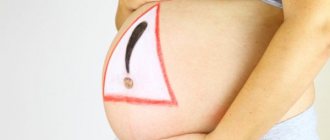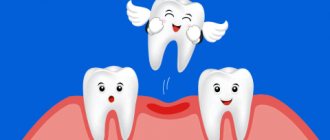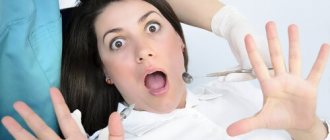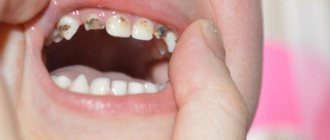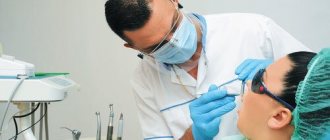How to pull out a baby tooth without pain
A baby is born without teeth because he does not need to chew food - breast milk or formula passes easily into the stomach.
At four to five months, the first milk teeth appear, which gradually fall out at five to seven years, being replaced by permanent teeth. You don’t have to go to the dentist to pull out a loose tooth—you can do it at home in a variety of ways. Before the procedure, it is important to make sure that the milk jug is ready for removal and that the child has no contraindications. Also, do not forget about cleaning the oral cavity after the procedure.
When can you pull out a child’s baby tooth at home?
Changing teeth is a natural and necessary process of development of the maxillofacial apparatus. The peculiarity of the structure of milk jugs is that they have short nerve roots, which makes their loss painless. In most cases, changing milk jugs occurs independently and does not require outside intervention. It is possible to remove a temporary tooth in cases where it is well loosened, but at the same time it interferes with speaking and chewing. In such situations, it is permissible to carry out the manipulation at home without visiting a doctor.
How to understand that you can pull out a child’s baby tooth:
- there is no pain or blood when the milkman staggers;
- healthy pink gums;
- the tooth moves easily back and forth in the hole;
- no stomatitis, gingivitis, tonsillitis;
- The child feels well and is healthy.
Contraindications to tooth extraction at home
Before choosing a method to extract a tooth yourself, it is important to make sure that this manipulation will not cause harm. The presence of the following manifestations is a contraindication for removing thrush at home:
- redness of the gums;
- strong adhesion of the tooth to the jaw;
- thickening of the gums due to swelling;
- the presence of blood or pain when the milkman staggers;
- increased body temperature, signs of acute respiratory viral infection, sore throat;
- the child has severe fear.
When performing a manipulation, you cannot hold the child by force, otherwise the fear of performing procedures in the mouth will remain for life. In all doubtful and complex cases, you should contact a specialized specialist - a pediatric dentist.
Children often experience carious lesions in primary teeth, leading to their partial destruction. Such situations require a mandatory visit to a doctor with subsequent treatment or removal. Even severely damaged carious teeth cannot be pulled out on your own - this will lead to pain and injury to the gums and lips.
Painless tooth extraction.
For painless tooth extraction, local anesthesia . Therefore, there is no need to worry about pain associated with this procedure. In this case, the main thing is to follow several rules of the postoperative period in order to minimize discomfort and pain:
- After tooth extraction, do not drink hot foods
- do not mechanically impact the removal site (tongue, food, toothbrush)
- do not rinse, do not drink alcohol, minimize physical activity
Depending on the specific situation and the task at hand, one of the methods of tooth extraction is used:
- traditional removal (mechanical removal)
- atraumatic removal (using ultrasound)
In some cases, tooth extraction involves serious surgical intervention, when not one of the above-mentioned options in its pure form is impossible due to one reason or another. Before removing a tooth, experts recommend taking an X-ray or tomography.
Kodak Carestream CS9300
Preparing a child for tooth extraction
Before pulling out a child’s tooth, it is important to carry out psychological preparation - explain in a calm voice the essence of the procedure and its purpose, emphasizing that it is not painful and quick. You can come up with a fairytale story about the milkman's journey or tell that mom and dad also had their temporary teeth pulled out.
You also need to ask the child to swing the tooth as much as possible with his tongue - this will make it possible to quickly pull it out of the gums. When the milkman wobbles, its short nerve endings are torn off or pulled out of the canals, so there is no pain syndrome.
Carrying out the procedure, simple tips
On the Internet you can find a lot of advice on removing temporary teeth, containing both descriptions of traditional methods and absurd proposals using improvised means. It is always important to think about the safety of the action for the child’s health and the possible consequences; it is better to give preference to one of the following two methods:
- use fingers and a handkerchief;
- apply thread.
Regardless of which manipulation it is decided to remove the milk duct, both participants in the procedure need preliminary preparation aimed at preventing infection. Before pulling out a baby tooth, an adult should thoroughly wash their hands with soap, and a child should rinse their mouth with warm water.
You can remove the milk jug like this: take a clean cloth, grab it and sharply pull it up if the tooth grows from the lower jaw or down if it grows from the upper jaw. This manipulation usually scares children, so they often resort to a more popular method. How to pull out a child's baby tooth using floss:
- Position the light source so that the oral cavity is well illuminated.
- Take a nylon thread about 30 cm long; tie one end to the loose tooth, making 4–5 turns around it; wrap the other around the index and middle fingers of an adult.
- Make a sharp movement with your hand, jerking your hand down if the milk duct grows on the upper jaw or upward for cases where the tooth is on the lower jaw.
Tooth extraction, if all conditions are met, takes no more than 5 minutes and is not accompanied by pain or other unpleasant sensations. Correctly performed manipulation does not leave the child afraid of the dentist and manipulations in the oral cavity.
Tips on how to pull out a tooth yourself correctly:
- position the thread so that it does not touch the lip, otherwise there is a risk of injury;
- do not use improvised means and tools;
- make sure the milk jug is ready to be removed.
If the tooth is well loosened, but the child is afraid to remove it with floss or fingers, and does not want to go to the doctor, you can give it an apple to chew on - solid food will cause the duct to fall out quickly and without pain.
Removing a baby tooth at the dentist -
Removal of temporary teeth in pediatric dentistry is most often performed under application or infiltration anesthesia.
Topical anesthesia involves the use of an anesthetic gel and spray (usually based on 10% Lidocaine). Under application anesthesia, it is permissible to remove teeth with 3-4 degrees of mobility, and infiltration anesthesia is used for slight mobility of 1 or 2 degrees. In most cases, articaine-based anesthetics are used - such as Ultracaine, Ubistezin or Septanest. Removing a baby tooth in children (video 2-3) –
We would also like to once again draw the attention of parents to the risks of removing sedentary primary teeth at home. Watch video 3 again - pay attention to the size of the roots of baby teeth. Fixed or slightly mobile baby teeth cannot be removed at home, and just trying to do so can lead to complications, as well as a child's negative attitude towards dental procedures for the rest of his life.
As for conduction anesthesia, it is not used to remove baby teeth - except in cases where a baby tooth on the lower jaw (4th or 5th molar) is removed against the background of purulent inflammation, for example, in the presence of a fistula or purulent abscess on the gum (in the form of cones). In such cases, conventional infiltration anesthesia will be ineffective. In very rare cases, removal can be carried out under sedation (inhalation or injection).
Sedation option (video 4) –
Oral hygiene after tooth extraction
Immediately after you have pulled out the tooth, you need to moisten a cotton ball with chlorhexidine and place it in the hole for 10 minutes. If a small amount of blood appears, then use hydrogen peroxide for these purposes - it not only disinfects, but also helps stop minor bleeding.
To form a full-fledged blood clot, as well as to prevent food particles from getting into the wound and causing infection, after the manipulation the child is not allowed to eat or drink for 2 hours. Please note that alcohol and vodka are not used to treat wounds in children.
Further care after baby tooth extraction:
- On the first day, brush your teeth without touching the socket with the brush. You should not use a paste - its components will irritate the wound surface.
- Rinse your mouth with chamomile decoction and a weak soda solution 4-5 times a day for 5-7 days. It is imperative to carry out this procedure after eating to remove food debris - otherwise an inflammatory process may develop.
- Eliminate salty, spicy and hard foods from the diet for 5 days. These products have an aggressive effect on the mucous membrane and can cause bleeding from the socket and pain.
- In children with frequent inflammatory diseases of the oral cavity, a warm antiseptic solution of furatsilin can be used for rinsing.
Author: Zhukov M.A.
Removal process
Since almost all dental procedures are now carried out using modern painkillers, the patient usually does not feel any discomfort, even during tooth extraction - the doctor can press on the molar, pull it out of the socket, and separate the roots. Of course, without anesthesia, pulling out teeth would be much more painful, if not completely impossible, so you should not be afraid of the procedure.
During the extraction, some people experience weakness, slight dizziness and malaise, which disappear after the removal and freezing are completed. The algorithm for removing a molar is as follows:
- expansion of the tooth socket in order to relax the compressed bone tissue (done by loosening the molar with special pressure);
- separation of the tooth from the ligaments with which it is attached to the socket;
- extraction of the molar from the causative site;
- applying a gauze pad.
Usually, if the actions are performed correctly, the tooth is extracted without difficulty; a problem can arise if the molar is too firmly secured or the structure of the roots is too complex. Then the dentist has to divide the root into parts and extract them one by one.
The pain begins to be felt after the tooth has been pulled out and the anesthetic has worn off, so you should not be afraid
The most impressionable patients experience panic at the moment the molar becomes loose, thinking that the doctor is even destroying the bone tissue of the jaws. The dentist can indeed press hard on the tooth, but the feeling of discomfort will not last longer than 2-3 minutes. Also, psychological comfort may be absent when removing wisdom teeth that are overgrown with gum - the doctor will first have to open the soft tissues, free and pull out the impacted molar, and after extraction, sew up the gum.

